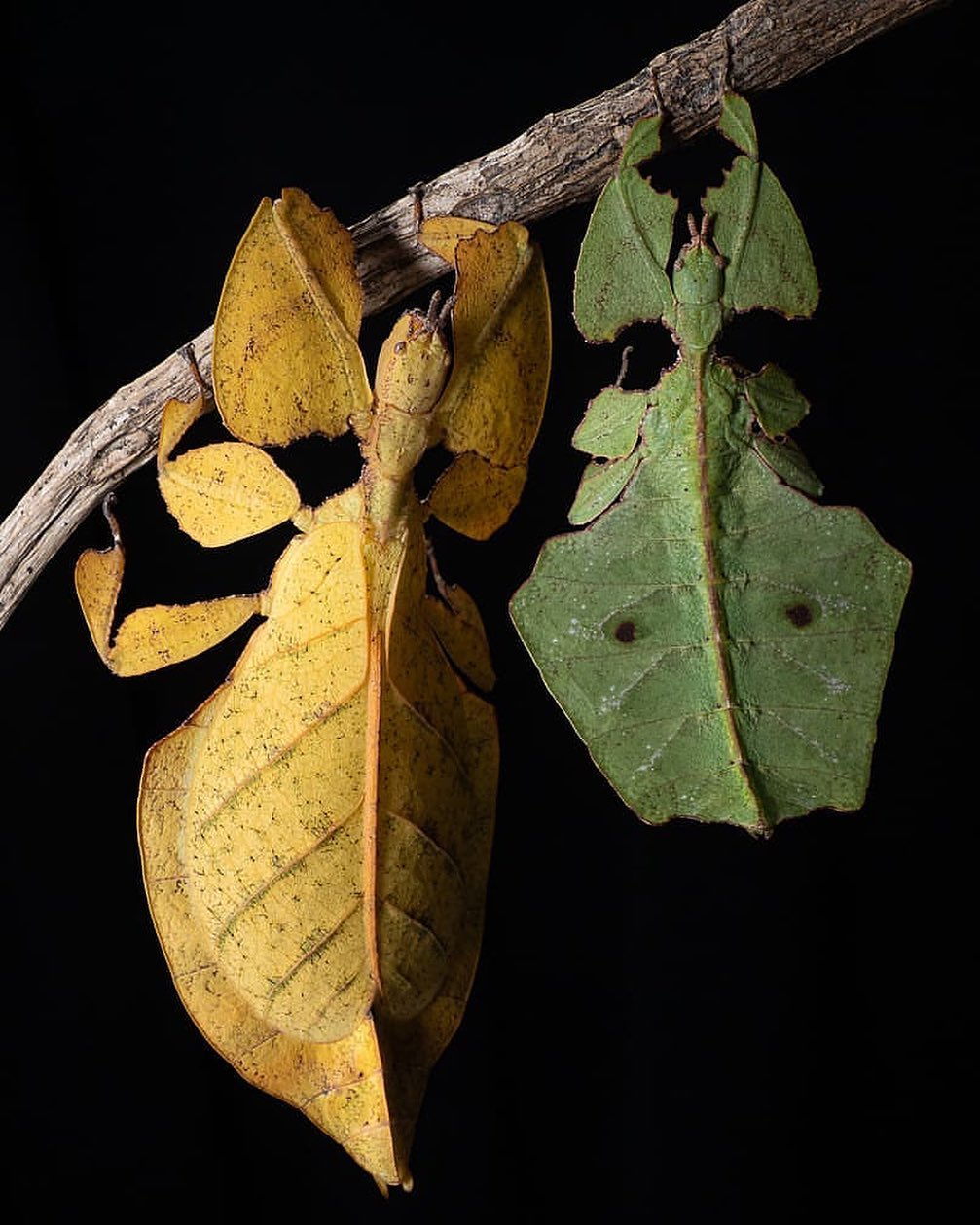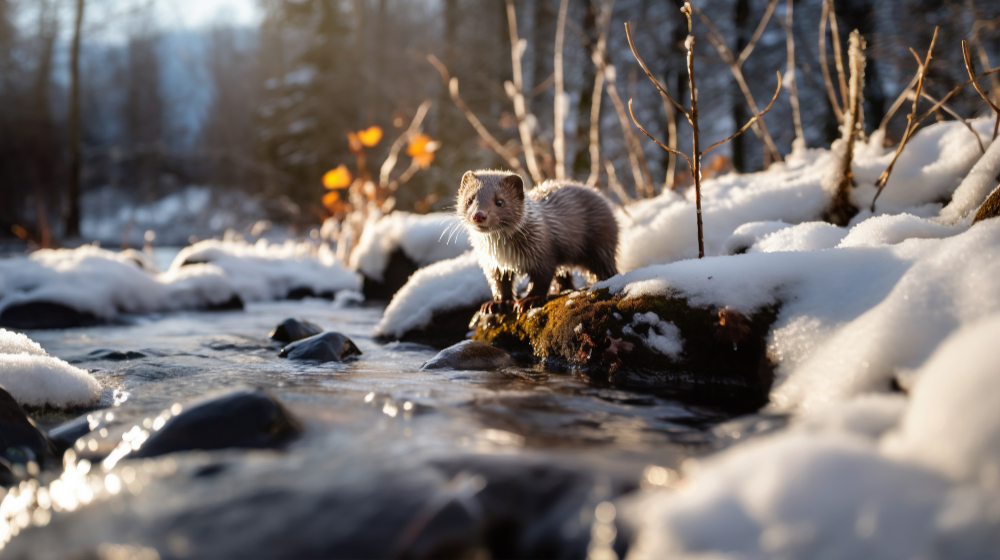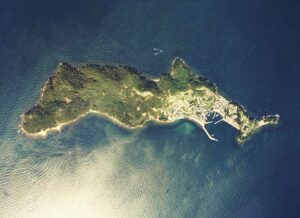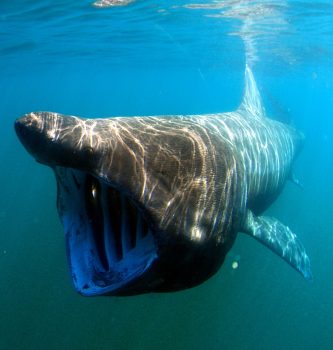 Pin
Pin Image from Pixabay
The deepest parts of the ocean begin beyond 200 meters, a place sunlight cannot reach. As we descend, pressure builds rapidly—crushing anything unfit to survive. In this pitch-black world, life has adapted in extraordinary ways, shaping creatures both haunting and beautiful. Their forms are nothing like what’s seen in shallower waters. The vast silence, freezing temperatures, and total darkness force evolution to push boundaries.
Creatures of darkness: life in the deepest parts of the ocean includes some of the most alien-looking beings on Earth. These organisms do not rely on sight. Instead, they develop other senses—pressure detection, heat sensitivity, and bioluminescence. It’s a reality shaped not by vision but by survival and touch.
The environment may seem empty, but it hosts a wide range of mysterious species. Some glow softly, others use their lights to hunt or hide. Everything that lives here tells a story of endurance, transformation, and deep mystery. The ocean’s floor is not dead—it is alive with wonder.
Table of Contents
The Anglerfish
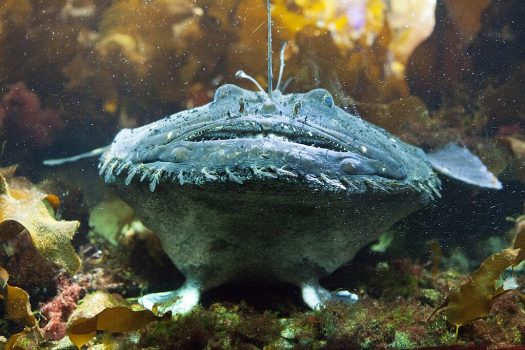 Pin
Pin Image from Wikimedia Commons
In the ocean’s deepest zones, where sunlight fails to reach, many creatures generate their own light. This phenomenon, known as bioluminescence, is common in the abyss. It’s not just for beauty—it’s a survival tool. Some species use it to lure prey. Others flash patterns to confuse predators or attract mates. In a world ruled by shadows, light is a rare and powerful gift.
One of the most iconic examples is The Anglerfish. It dangles a glowing lure above its mouth to tempt smaller fish. The moment a curious snack swims close, it’s gone in a snap. Other creatures like jellyfish pulse with ghostly blue or green glows, drifting like floating lanterns. Their light dances through the water, hypnotic yet deadly.
Even bacteria in this region can glow, forming symbiotic relationships with their hosts. For many species, this built-in light is more essential than eyes. In these depths, light isn’t just a tool—it’s a language. Each flicker and flash is a message written in nature’s ancient code.
The Hatchetfish
 Pin
Pin The Hatchetfish / Image from Pixabay
Many deep-sea animals survive not by fighting or fleeing, but by becoming invisible. In this dark world, the ability to vanish is a powerful defense. Some species, like the glass octopus, are nearly transparent. Their organs float inside them like little beads, hidden from predators who rely on movement or shadow to detect prey.
Other creatures have developed unique types of camouflage. The Hatchetfish, for instance, has silver scales that reflect any faint light from above, blending perfectly with the dim surroundings. It’s a clever disguise that fools both predators and prey. Some squid even control how light passes through their skin, shifting colors or patterns in an instant.
Stealth is not limited to looks. Many deep ocean animals move slowly and silently, creating no vibrations in the water. This stillness makes them harder to detect. In a place where one wrong flick of a fin can mean death, mastering silence and shadow can mean the difference between survival and being swallowed whole.
The Frilled Shark
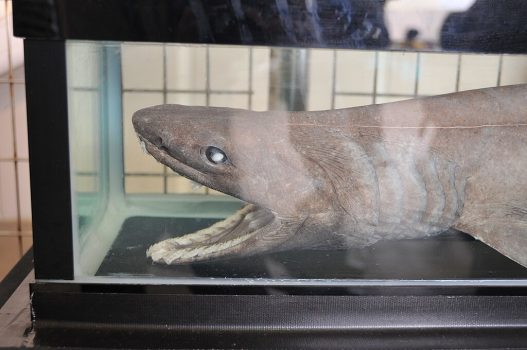 Pin
Pin Image from Wikimedia Commons
Some deep-sea creatures have changed very little over millions of years. These living fossils remind scientists of Earth’s distant past. In the darkness and pressure of the deep, evolution often slows down. Creatures like the frilled shark and the coelacanth still roam these depths, looking much as they did before dinosaurs went extinct.
The Frilled Shark, with its eel-like body and rows of needle-sharp teeth, hunts by lunging at prey in sudden bursts. It’s rarely seen by humans but occasionally caught in deep-sea nets. The coelacanth, once believed extinct, was found alive in 1938. Its discovery shocked scientists and opened up new questions about what other “extinct” species might still survive.
These ancient beings tell us that the ocean’s depths are like a time capsule. While the surface world evolved rapidly, the abyss preserved a more ancient rhythm. These creatures continue to live in slow motion, moving through black waters as they have for ages—untouched, unchanged, and largely unknown.
The Fangtooth Fish
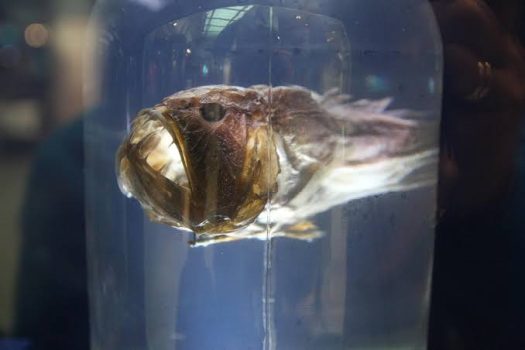 Pin
Pin Image from Pixabay
Hunting in the deep sea is unlike anything on the surface. There’s no chasing under the sun or darting through coral reefs. Down here, patience and precision rule. Many predators lurk silently in the darkness, waiting for the perfect moment. Their attacks are sudden, often over in seconds. Teeth, tentacles, and traps are shaped by evolution to catch meals in a place where food is scarce.
The gulper eel is one such predator. With a mouth that can unhinge and stretch, it swallows prey much larger than its head. The Fangtooth Fish, with jaws so large they can barely close, survives with powerful senses and brutal speed. These are not graceful hunters—they’re opportunistic survivors in a world where one missed meal can mean death.
Prey animals have their own defenses. Some puff up to appear bigger. Others release glowing fluids to distract. In the ocean’s darkest places, the dance between predator and prey is constant. Each has evolved for a single goal—outsmarting the other to survive.
The Yeti Crab
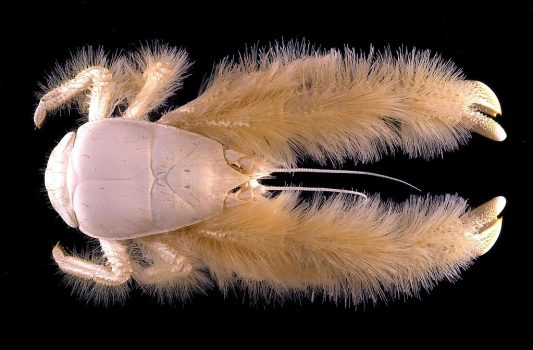 Pin
Pin Image from Wikimedia Commons
Not all deep-sea creatures rely on speed or stealth. Some build. These underwater architects reshape their environment in quiet, patient ways. Tube worms, for example, cluster around hydrothermal vents, forming towering colonies. These tubes, made from minerals in the water, become entire neighborhoods for other species. In a place once thought lifeless, they create ecosystems.
Then there’s The Yeti Crab, a fuzzy-looking crustacean discovered near volcanic vents. It “farms” bacteria on its hairy claws, waving them through the water to help the microbes grow. The crab then scrapes and eats them. It’s a strange form of agriculture in the blackest depths of the sea. Such behavior shows how complex life can become, even without sunlight or plants.
Some fish dig nests or build rock formations. Others lay trails of mucus to trap prey. Each of these actions may seem small, but they shape the ocean floor. These builders turn bare seascapes into living, breathing homes—proving that even in darkness, life doesn’t just survive, it creates.
Life Around Hydrothermal Vents - The Worms
In the deepest trenches of the ocean, where volcanic activity cracks the seafloor, hydrothermal vents blast scalding, mineral-rich water into the sea. These vents create oases of life. Despite boiling temperatures and toxic chemicals, entire ecosystems gather around them. What’s remarkable is that life here doesn’t rely on sunlight—it feeds off chemicals through a process called chemosynthesis.
Giant tube worms, clams, and vent crabs crowd these hotspots. They live in partnership with bacteria that convert vent chemicals into energy. This relationship is essential. The worms, for example, have no mouths or stomachs. Instead, the bacteria live inside their bodies, providing nutrients in exchange for shelter. It’s a system unknown in sunlit environments.
Each vent community is a world of extremes—heat, pressure, and poison. Yet these places are rich with life. Scientists study them to understand how life might exist on other planets, like under the ice of Jupiter’s moon Europa. In the deep ocean, vents prove that even the harshest places can be full of vibrant, unique life.
The Blobfish
 Pin
Pin Image from Wikimedia Commons
In the deep ocean, evolution takes strange turns. Creatures here often break the rules of biology we see on land or in shallow seas. Some fish, like the barreleye, have transparent heads, revealing their rotating eyes. Others, like the deep-sea dragonfish, can create red light—a rare ability in the deep, where most species can’t even see it. This gives them an invisible spotlight to stalk their prey.
Then there are gelatinous creatures with no bones or defined shapes. The Blobfish, for example, looks like a melting face when taken to the surface, but in its natural high-pressure home, it’s quite normal. Its jelly-like body helps it float just above the sea floor with minimal energy.
These animals don’t just survive in a hostile environment—they redefine how survival works. Their bodies are made not for speed or strength, but for endurance, stealth, and efficiency. Every strange feature tells a story of adaptation, reminding us how flexible and creative nature can be when tested by the deep.
Sperm Whales
In the pitch-black ocean depths, sound travels farther than light. Many deep-sea creatures rely on vibrations, pulses, and clicks to sense their surroundings or communicate. Some fish use drumming muscles to produce low sounds. Others generate clicking noises to attract mates or warn rivals. Even in silence, the deep sea has its own language.
Whales, particularly Sperm Whales, dive deep and send out powerful clicks that bounce off objects. These sounds help them hunt giant squid in the dark. Shrimp-like creatures known as Snapping Shrimp can create loud bursts that stun prey or signal territory. The deep is not as quiet as it seems—it’s full of rhythms shaped by need and survival.
Sound also helps animals avoid danger. Certain fish can detect the low hum of an approaching predator and freeze instantly. Others respond to shifts in pressure and current. Communication in the deep may not be visual, but it’s constant. In the darkness, every thump or whisper could mean food, threat, or something entirely unknown.
Threats to Deep Ocean Life
Even in the farthest corners of the sea, human activity has left a mark. Deep ocean creatures, once protected by distance and depth, now face rising threats. Deep-sea mining targets minerals found near hydrothermal vents, disturbing fragile ecosystems that took thousands of years to form. These slow-growing creatures can’t recover quickly from such damage.
Plastic pollution has reached the deepest ocean trenches. Tiny microplastics have been found in the guts of amphipods living seven miles below the surface. These pollutants enter the food chain and harm animals that have no defense against them. Noise from shipping and underwater drilling also disrupts communication among deep-sea species.
Climate change warms the ocean and reduces oxygen levels, pushing species to the edge. The deep sea is not a silent world untouched by our hands—it is part of the global system, deeply connected to life above. Protecting it means understanding its importance and respecting the ancient life it holds. Without care, these creatures of darkness may quietly vanish.
FAQs
Many deep-sea creatures are found below 200 meters, in zones where sunlight no longer penetrates. Some live as deep as 11,000 meters in oceanic trenches like the Mariana Trench.
This glow, known as bioluminescence, helps creatures hunt, hide, or communicate in total darkness. It’s produced by special chemicals or symbiotic bacteria in their bodies.
Yes, but it’s extremely challenging. Only a few manned submersibles and robotic vehicles can withstand the crushing pressure at those depths for short periods.
Most are harmless. They live far below human reach and have no interaction with people. However, some have sharp teeth or venom used for hunting prey.
It hosts unique life, regulates Earth’s climate, and stores carbon. Damaging its ecosystems can have ripple effects across the entire planet, including life on land.

